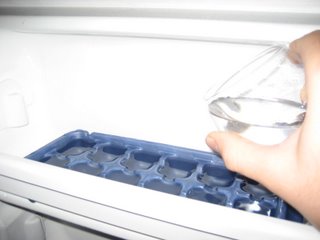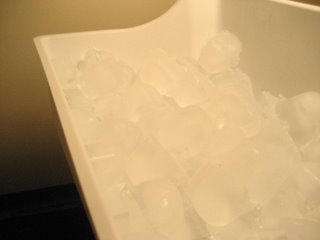ECLIPS: A new method of ice production for homes without ice machines
Traditional approaches have focused on surface area and, to a lesser extent, shape as the primary variables for manipulation in domestic ice production. Wilen (2004) embodies this conventional wisdom: "A smaller ice cube is to be recommended for its superior surface area-to-volume ratio, which cools drinks faster, and for its versatility, which allows it to be used for medical purposes as well as recreational ones". Wilen's sloppy writing fits well with his atrocious argument construction; as we shall see, the conventional wisdom on ice production is a card house. When we realize that larger ice cubes are equally appropriate for over 95% of the tasks needed for ice as small cubes, this card house begins to fall apart. We discover that the high labor costs associated with smaller ice cubes are one more ingredient in the immoral oppresion of women and minorities. We find that the bourgeois snobbery associated with the Artisanal Ice Movement is even more hollow than it appears. Indeed, we find that all ice machines, as long as they freeze water in a safe and efficient manner, can produce ice equally as valuable as that produced by the most sophisticated artisanal producers.
All of this depends on a simple trick, one that every child learns in her high school chemistry class: with the introduction of stirring, shaking or any other method of circulation, the size of the ice cubes in any beverage quickly becomes irrelevant. Thus the choice of a mode of production for consumable ice need no longer be made on the basis of size or shape. Now, after the advent of ice packs for inflammation reduction, this finding has the potential to change ice production completlely, because consumable ice, ice used for internal cooling of beverages, now accounts for 95.6% of all ice consumed in America. Significant gains in efficiency can be gained because of this new finding.
It is not prima facie evident that large ice cubes are more easily produced than small ones. After all, the large surface area-to-volume ration associated with small ice cubes means that they will be produced much more quickly in a conventional freezer. But this focuses too much on the immediate production of ice cubes and ignores the regular patterns associated with ice consumption and the fact that ice can be stored. With these insights in mind, we can observe that, ceteris paribus, the most important variable in choosing a mode of ice production is cost. It is obvious, then, that the icemaking machine is by far the most efficient method, as human labor is the most accounts for 98% of the cost of ice production. But what about those homes which do not have the use of an ice machine? Obviously, the best practice production method will be that which minimizes labor consumption. That method is the extremely cubical, large ice production system (ECLIPS), which I have developed in my domestic research laboratory in Washington, DC.
I observed that ice cube producers attempt to minimize their labor commitment by reducing the number of times they filled ice trays instead of filling trays more quickly. This follows our traditional understanding of the cognitive requirements involved in beginning discrete tasks: when evaluating the efficiency in a given process, people take into consideration the fact that changing ones focus involves a significant amount of energy; it thus becomes rational to minimize the quantity of attention shifts involved in any given task. My studies indicated that most ice producers would prefer only to make ice once or, at most, twice a day.
But a second observation was also essential to the development of ECLIPS: ice producers often have significant space constraints. This means that most ice producers (72% +/- 12% with 95% confidence) are limited to two producing trays and one storage unit.
The ECLIPS system attempts to maximize this limited space by filling trays to the highest feasible level. But the genius of ECLIPS comes in the method for filling said ice trays. Instead of filling them to their maximum capacity before transfer to the freezer, the ECLIPS method enlists the support of another device, a small cup, "top off" the trays once they are already in the freezer. This prevents unnecessary spillage, reducing the variability in expected labor time that was formerly considered an inherent part of ice production.

(A) "Topping off" the ice tray

(B) A full storage unit
As you can see below, the end product is suitable for any beverage cooling purpose. The larger cube is significantly more massive and thus provides more cooling power per unit of time invested. The greater volume of the cube produced means that ECLIPS users fill an ice storage unit much more quickly than producers using other methods. In addition, the cube has superior aesthetic qualities--even artisan ice makers, who produce the smallest cubes available to civilians, have admitted that a larger cube is more interesting due to the complexity of its crystal structure. ECLIPS is therefor not only a small step towards the liberation of the domestic class, but a method for increasing the amount of aesthetic pleasure received by ice consumers of all classes.

(C) The superior aesthetic qualities of large ice cubes are self-evident.
All of this depends on a simple trick, one that every child learns in her high school chemistry class: with the introduction of stirring, shaking or any other method of circulation, the size of the ice cubes in any beverage quickly becomes irrelevant. Thus the choice of a mode of production for consumable ice need no longer be made on the basis of size or shape. Now, after the advent of ice packs for inflammation reduction, this finding has the potential to change ice production completlely, because consumable ice, ice used for internal cooling of beverages, now accounts for 95.6% of all ice consumed in America. Significant gains in efficiency can be gained because of this new finding.
It is not prima facie evident that large ice cubes are more easily produced than small ones. After all, the large surface area-to-volume ration associated with small ice cubes means that they will be produced much more quickly in a conventional freezer. But this focuses too much on the immediate production of ice cubes and ignores the regular patterns associated with ice consumption and the fact that ice can be stored. With these insights in mind, we can observe that, ceteris paribus, the most important variable in choosing a mode of ice production is cost. It is obvious, then, that the icemaking machine is by far the most efficient method, as human labor is the most accounts for 98% of the cost of ice production. But what about those homes which do not have the use of an ice machine? Obviously, the best practice production method will be that which minimizes labor consumption. That method is the extremely cubical, large ice production system (ECLIPS), which I have developed in my domestic research laboratory in Washington, DC.
I observed that ice cube producers attempt to minimize their labor commitment by reducing the number of times they filled ice trays instead of filling trays more quickly. This follows our traditional understanding of the cognitive requirements involved in beginning discrete tasks: when evaluating the efficiency in a given process, people take into consideration the fact that changing ones focus involves a significant amount of energy; it thus becomes rational to minimize the quantity of attention shifts involved in any given task. My studies indicated that most ice producers would prefer only to make ice once or, at most, twice a day.
But a second observation was also essential to the development of ECLIPS: ice producers often have significant space constraints. This means that most ice producers (72% +/- 12% with 95% confidence) are limited to two producing trays and one storage unit.
The ECLIPS system attempts to maximize this limited space by filling trays to the highest feasible level. But the genius of ECLIPS comes in the method for filling said ice trays. Instead of filling them to their maximum capacity before transfer to the freezer, the ECLIPS method enlists the support of another device, a small cup, "top off" the trays once they are already in the freezer. This prevents unnecessary spillage, reducing the variability in expected labor time that was formerly considered an inherent part of ice production.

(A) "Topping off" the ice tray

(B) A full storage unit
As you can see below, the end product is suitable for any beverage cooling purpose. The larger cube is significantly more massive and thus provides more cooling power per unit of time invested. The greater volume of the cube produced means that ECLIPS users fill an ice storage unit much more quickly than producers using other methods. In addition, the cube has superior aesthetic qualities--even artisan ice makers, who produce the smallest cubes available to civilians, have admitted that a larger cube is more interesting due to the complexity of its crystal structure. ECLIPS is therefor not only a small step towards the liberation of the domestic class, but a method for increasing the amount of aesthetic pleasure received by ice consumers of all classes.

(C) The superior aesthetic qualities of large ice cubes are self-evident.

1 Comments:
It's not fair to let this post go to the archives without letting you know that it's one of the funniest things I've ever seen.
Post a Comment
<< Home